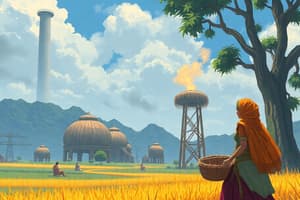Podcast
Questions and Answers
What was the significance of the Green Revolution in Indian agricultural history?
What was the significance of the Green Revolution in Indian agricultural history?
- It led to a decrease in food grain production.
- It focused on reducing agricultural productivity.
- It increased food production and rural incomes. (correct)
- It brought India closer to dependence on food imports.
When did the Indian government start implementing reforms to modernize the agricultural sector?
When did the Indian government start implementing reforms to modernize the agricultural sector?
- 1800s
- 1960s and 1970s (correct)
- Late 1990s
- Early 1900s
What role did the agricultural sector play in India's economy for centuries?
What role did the agricultural sector play in India's economy for centuries?
- Backbone of the economy (correct)
- Main source of imports
- Primary focus of foreign investments
- Negligible role
In what ways did the Green Revolution transform India's agricultural landscape?
In what ways did the Green Revolution transform India's agricultural landscape?
What has been the focus of India's continued agricultural reforms since the Green Revolution?
What has been the focus of India's continued agricultural reforms since the Green Revolution?
What percentage of India's GDP did the agricultural sector contribute to as of 2022?
What percentage of India's GDP did the agricultural sector contribute to as of 2022?
Which pillar of India's economy is heavily dependent on agriculture according to the text?
Which pillar of India's economy is heavily dependent on agriculture according to the text?
What were some challenges faced by India's agricultural sector as mentioned in the text?
What were some challenges faced by India's agricultural sector as mentioned in the text?
How did the Indian government address concerns related to foreign investments?
How did the Indian government address concerns related to foreign investments?
Which sector in India experienced rapid expansion due to foreign investment according to the text?
Which sector in India experienced rapid expansion due to foreign investment according to the text?
Flashcards are hidden until you start studying
Study Notes
Indian Economic Development: Focus on Agriculture and Foreign Investments
India, a vast and diverse nation, has a rich history of economic transitions, marked by complex challenges and promising transformations. In the realm of economic development, the agricultural sector and foreign investments have played significant roles in shaping India's growth trajectory.
Agricultural Sector
Agriculture has been the backbone of India's economy for centuries, supporting livelihoods, providing food security, and bolstering the country's exports. However, it was not until the 1960s and 1970s that the Indian government began implementing reforms to modernize the agricultural sector.
The Green Revolution
The Green Revolution, initiated in the 1960s, was a pivotal moment in Indian agricultural history. By introducing high-yielding crop varieties, scientific farming methods, and affordable credit, the government successfully transformed India's agricultural landscape, increasing food production and rural incomes. The Green Revolution led to a reduction in poverty and a substantial increase in food grain production, bringing India closer to achieving self-sufficiency in food grains.
Agricultural Reforms
Since the Green Revolution, India has continued to introduce reforms to improve the agricultural sector, focusing on increasing productivity, promoting mechanization, and expanding irrigation systems. For example, the National Agricultural Policy of 2000 aimed to boost agricultural productivity, raise farm incomes, and facilitate better marketing of agricultural produce.
Agricultural Growth and Challenges
As of 2022, India's agricultural sector contributed to about 15.4% of its GDP, with 43% of the population dependent on agriculture, making it a vital pillar of India's economy. However, the sector continues to face challenges, such as inadequate irrigation systems, low productivity, and price volatility. Despite these challenges, India remains committed to modernizing the agricultural sector to boost productivity, sustainability, and farmers' incomes.
Foreign Investments
Foreign investments have played a crucial role in India's economic development since the 1990s, when the government began implementing liberalization and privatization reforms. The influx of foreign capital has led to the growth of India's industries, infrastructure, and services sectors, enhancing the country's economic competitiveness.
Foreign Direct Investment (FDI) Policy
In the 1990s, the Indian government instituted major reforms to the FDI policy, allowing for greater foreign participation in various sectors of the economy. The government simplified approval processes, reduced restrictions, and offered incentives to attract foreign investment. As a result, India's FDI inflows increased significantly, contributing to economic growth, job creation, and technological advancements.
Foreign Investment in Specific Sectors
Foreign investments have been particularly beneficial to India's infrastructure, manufacturing, and services sectors. For instance, foreign investment in India's telecom sector has led to the rapid expansion of mobile networks, improving the accessibility and affordability of telecommunications services for millions of Indians.
Challenges of Foreign Investments
While foreign investments have contributed to India's economic development, they have also raised concerns regarding job displacement, technology transfer, and capital flight. The Indian government has attempted to address these concerns through policy reforms, such as encouraging domestic manufacturing, protecting intellectual property rights, and tightening regulation on capital flows.
Conclusion
India's economic development, driven by the transformation of the agricultural sector and the influx of foreign investments, has resulted in significant progress over the past few decades. The challenges facing the agricultural sector and foreign investments continue to be pressing, but India remains committed to modernizing its agricultural sector and attracting foreign capital to power its growth and development. As India continues to evolve, it will be essential to address the challenges facing these critical sectors to maintain its positive trajectory and achieve the objectives of inclusive and sustainable economic growth.
Studying That Suits You
Use AI to generate personalized quizzes and flashcards to suit your learning preferences.




